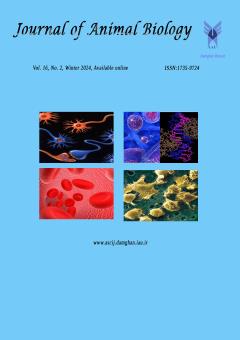Comparison of Morphometric and Histological Parameters of Spleen in Balb/c and C57BL/6 Strains of Mice Raised in the Same Conditions
Subject Areas : Journal of Animal Biology
Morteza Abbaspour
1
![]() ,
Samad Farashi Bonab
2
*
,
Samad Farashi Bonab
2
*
1 - Department of Veterinary Medicine, Garmsar Branch, Islamic Azad University, Garmsar, Iran
2 - Department of Immunology, Faculty of Medicine, Tehran University of Medical Sciences, Tehran, Iran
Keywords: Mouse, Balb/c, C57BL/c, Spleen, Histology,
Abstract :
Spleen is the largest lymphatic organ of the body and plays a role in blood purification, storage of red blood cells, removal of damaged old red blood cells and creation of specific immune responses. Some studies have shown that the spleen tissue has differences in some species. Since Balb/c and C57BL/6 bi-strain mice are chosen as the first choice in many biological researches, it is necessary to carefully evaluate the anatomical, histological and genetic differences between them in order to develop study models be chosen correctly. Therefore, the present study was conducted with the aim of investigating the morphometric and histological characteristics of spleen tissue in Balb/c and C57BL/6 mice. 10 Balb/c female mice and 10 C57BL/6 female mice were bred in the animal house under the same conditions. Then the spleen of mice was examined in terms of morphometric and histological characteristics. The data obtained from two groups were analyzed with t-set method and p < 0.05 was considered significant. The results showed that the shape and color of the spleen in mice do not differ significantly. The average spleen weight in Balb/c mice was slightly higher than that of C57BL/6 mice, which was not statistically significant. In the slides prepared from the spleen tissue of Balb/c and C57BL/6 mice, no visible difference was detected between the mice's spleen in terms of histology.
1. Cesta M.F. 2006. Normal structure, function, and histology of the spleen. Toxicologic Pathology, 34(5):455-465.
2. Dijkstra C.D., Veerman A. 1990. Normal anatomy, histology, ultrastructure, rat. Hemopoietic System, 1990:185-193.
3. Fallahi R. 2022. Review on anesthesia and injections in laboratory mice. Iranian Journal of Biology, 6:168-174.
4. Haley P.J. 2017. The lymphoid system: a review of species differences. Journal of Toxicological Pathology, 30(2):111-123.
5. Hensel J.A., Khattar V., Ponnazhagan S. 2019. Characterization of immune cell subtypes in three commonly used mouse strains reveals gender and strain-specific variations. Laboratory Investigation, 99(1): 93-106.
6. Hoppe I., Brenneke B., Rohde M., Kreft A., Haussler S., Reganzerowski A. 1999. Characterization of a murine model of melioidosis: comparison of different strains of mice. Infection and Immunity, 67(6):
2891-2900.
7. Kazemi A.H., Razmaraii N., Samadirad B. 2011. Animals’ rights in biomedical research. Medical Ethics, 5(15):63-82.
8. Kapila V., Wehrle C.J., Tuma F. 2019. Physiology, spleen. StatPearls [Internet]: StatPearls Publishing.
9. Mebius R.E., Kraal G. 2005. Structure and function of the spleen. Nature Reviews, Immunology, 5(8):606-616.
10. Pilehvarian A.A., Karimi A. 2019. Study of changes in blood cells and spleen tissue on days 10 and 20 of pregnancy and the first week of lactation in rats. Journal of Ilam University of Medical Sciences, 26(5):20-29.
11. Shakerzadeh J., Movahedin M., Eidi A., Hayati Roodbari N., Parivar K. 2022. Evaluation of different strain mice during in vitro fertilization and embryo development in response to superovulation. Medical Science Journal of Islamic Azad University-Tehran Medical Branch, 32(1):53-63.
12. Steiniger B.S. 2015. Human spleen microanatomy: why mice do not suffice. Immunology, 145(3):334-346.
13. Trunova G., Makarova O., Diatroptov M., Bogdanova I., Mikchailova L., Abdulaeva S. 2011. Morphofunctional characteristic of the immune system in BALB/c and C57BL/6 mice. Bulletin of Experimental Biology and Medicine, 151: 99-102.

